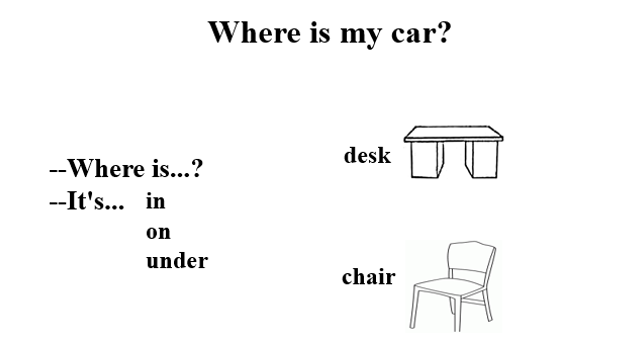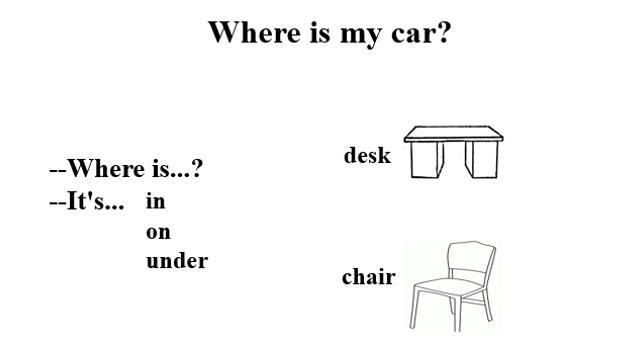关键词: 全国招教

《Wher is my car? Part A Let’s learn》试讲稿
I.Teachingprocedure
Good morning, my dear judges. I’m No. 2 candidate, applying for primary school English teacher. My topic is Unit 4 Wher is my car? Part A Let’s learn. May I begin now? OK, thank you.
Step 1. Warm-up and Lead-in
T: Good morning, boys and girls, how are you today?
S: …
T: Yeah, I’m fine too. Thank you. How about singing a song together before our lesson?
On, in, under, on in, under, on in under, wher is my pencil box?
On in under, on in under, on in under, wher is my eraser?
T: Great, you did a good job. Your singing is beautiful.
Step 2. Presentation
T: School things are very important for us. I can see there are many things on your desk. What’s on your desk?
S: …
T: Yes, there are many books and a pencil box on your desk. What’s in your desk?
S: …
T: Good, your school bag is in your desk.
T: Read after me, desk desk. [e] [e] desk.【转身板书该核心单词】
S: …
T: I also have many books on my desk. But I can’t find my dictionary, wher is it? Can you help me? Wow, it’s under my chair. [tʃ] [tʃ] chair. Read after me, boys and girls, chair 【升调读一遍】chair【降调读一遍】. 【转身板书该核心单词】
S: …
T: You have so many things on your desks. Do you think you have a clean desk? Yes or no?
S: …
T: Great. You think you have a clean desk at school. Do you have a clean desk at home? I don’t know, but I hope so.
T: Look at this picture. Who is it? Yes, it is our friend –lovely Zip. It is a happy squirrel. We can see it smiling often. But what is going on here? Zip is not very happy now. Can you guess?
S: …
T: Good guess. But I’m not sure. Maybe Zip is thinking about something. Zip needs our help. How about listening to the radio and find out? Wher is Zip? What is Zip doing?
【教师播放录音】
T: Who can answer the questions? Linda, have a try.
S: …
T: Zip is on the desk. She is looking for something. What is she looking for?
S: …
T: Bingo! She’s looking for a ruler. Wher is her ruler?
S: …
T: Right. Her ruler is under the chair.
Step 3. Practice
Activity 1. Let’s chant
T: Boys and girls, the little bird and us help Zip find her ruler. It’s important for us to remember wher we put things. Do you agree? Great. Now, I have a chant for you. Let’s chant together.
On, on, on the desk. I put my pencil box on the desk.
In, in, in the desk, I put my schoolbag in the desk.
Under, under, under my desk, I don’t put my books under the desk.
【教师边说边做出相应的动作】
S: …
T: Great, you are so lovely.
Activity 2: Pair work
T: Boys and girls, I want to show you a picture of my study. Oh, do you like it? You don’t like it. Why?
S: …
T: You think I didn’t put things in right places. Oh, wher is the ruler? Wher is the bag? Can you help me to put them away? Wher can we put the pencil/ ruler/ pencil box/ ,..? Now discuss in pairs.
S: …
T: Which pair wants to share your discussion? OK, this pair comes to the front please.
S: …
T: You set a good example for us. Let’s clap for them.
Step 4. Consolidation.
Design our own study
T: Boys and girls, I have many stickers of things in study. Look, what are they?
S: …
T: I prepare stickers of ruler, schoolbag, pencils, pencil box, chair, wow. There are also some lovely animal toys. It’s your turn to design your own study. Listen to me carefully. Stick a chair on the paper. Stick a desk on the paper. Stick a toy bear on the paper. Stick a schoolbag on the paper….
S: …
T: Have you finished? I have finished my study. Wher is my schoolbag? Wher is my desk? Wher is my chair?
S: …
T: Wow, my picture is the same as yours. We are friends. Boys and girls, now stand up and walk around the classroom to ask your classmates likes this and find your friends. Is 5 minutes enough? Here we go!
S: …
T: Time is up. Let me see who have many friends in our class. Good. You all did great job. Congratulations.
Step 5. Summary
T: It’s time to say goodbye. Today we’ve learnt how to put our things in right places. That’s very important in our daily life.
Step 6. Homework
T: After class, please draw your own bedroom as you wish. You can also surf the Internet for more pictures. Take it to share with your classmates next time. So much for today, good bye.
That’s all for my presentation. Thank you very much for listening.
II. Blackboarddesign

《Wher is my car? Part A Let’s learn》说课稿
Good morning, dear judges. Today, it is my honor to stand here to present my lesson. First of all, let me introduce myself. I’m candidate NO.2, applying for the English teacher of primary school and my topic is Wher is my car. In order to make it clear, I will express my thoughts from the following six parts, which are the analysis of the teaching material, analysis of students, teaching methods, learning methods, teaching procedures and blackboard design. Now I am going to present them one by one.
I. Analysis of the teaching material
Next, I will briefly introduce the first part: analysis of teaching material. Today’s lesson is from unit 4 of Book 2, published by PEP. It’s about describing the places of things. Students can learn to talk about places of things with sentences “Wher is…?”; “Is it …?” and several prepositions, such as on, under and in. Besides, the topic of this unit is familiar to students’ daily life, so it can attract students’ interest easily.
Teaching Objectives
Given the analysis of teaching material, the teaching objectives are designed as follows:
1. Students can recognize, understand, and speak the following key words: in, on, under, desk, chair. Meanwhile, they can understand and make use of the key sentence patterns “Wher is …? It’s …”
2. Developing students’ ability of communication with other people in English is a challenging objective. Students can use the new words and the sentences to make a conversation and thus their listening skills and speaking will be improved.
In addition, to better apply what they have learned in this lesson, students can use the words and sentences to describe the locations of things around them correctly.
3. Given that lots of Chinese students are shy to speak English, one emotional objective of this lesson is to encourage students to be brave to speak English by giving them more opportunities to speak English.
Their awareness of putting school things in right places can also be fostered.
Key and Difficult Points
based on the teaching objectives, the teaching key point and difficult point is to help students learn to ask and answer the location of things with the key words and sentence patterns.
II. Analysis of students
After the analysis of teaching material, now let me analyze the students. Students in grade 3 are around age of 8 or 9. Students around this age are eager to learn and eager to explore new things.
They have just learned English for one semester. They have interest in learning more English related to their surroundings. So, in this lesson, students can learn more words and sentences to improve their language ability. What’s more, they are forming the ability to explore English knowledge and skills with some teaching aids such as pictures, radios, and songs.
III. Teachingmethods
based on the analysis of teaching material and students, I will choose situational, task-based language teaching and audio-lingual approach to help students engage in class. The teaching methods combined can make students learn to play and play to learn.
IV. Learningmethods
According to teaching objectives and students’ characteristics, in this class, students will get knowledge by individual work and cooperative learning. With these methods, students will work in pairs and in groups to grasp the new phrases and the sentences, which makes this lesson more active and effective.
V. Teachingprocedure
According to the above analyses, now, let me introduce the most important part: teaching procedures. I will introduce it from the following steps.
Step 1.Warming up and Leading in
For this step, I will start with a song like this:
On, in, under, on in, under, on in under, wher is my pencil box?
On in under, on in under, on in under, wher is my eraser?
By singing a song together, students’ attention is easily drawn to the lesson naturally, which helps to form a better English learning environment and lead the topic in.
Step 2. Presentation
In this step, I will present the key words of this lesson by talking with students naturally. For example, I will say like this:
School things are very important for us. I can see there are many things on your desk. What’s on your desk? What’s in your desk?
In this way, I can teach the word “desk” and help students to get familiar with the words on and in. Then, I will use some others things to attract students’ attention to the word “chair”. I will say like this:
I also have many books on my desk. But I can’t find my dictionary, wher is it? Can you help me? Wow, it’s under my chair. [tʃ] [tʃ] chair.
So that the new words chair and under are taught.
In students’ text book, there is a situation that the squirrel Zip is looking for her things on the desk, the bird is helping her. I will use this situation to help students learn the new words again. I will play the tape for students, ask students to listen to the conversation between Zip and the bird, thus to be familiar with the new words again.
Step 3. Practice
For this step, I will guide students to take part in 2 activities.
Activity 1. Let’s chant
I will chant with students together to practice the key words of this lesson. The chant is like this:
On, on, on the desk. I put my pencil box on the desk.
In, in, in the desk, I put my schoolbag in the desk.
Under, under, under my desk, I don’t put my books under the desk.
I will chant with actions and ask students to follow me. This activity can help students practice while playing.
Activity 2. Pair work
I will provide students with a picture of his or her messy study. Then I will elicit students to work in pairs to talk about wher the things should be put and then make a dialogue.
In this way, students can practice the new words and sentences together in a real situation. Meanwhile, their awareness of putting things away ca be fostered.
Step 4. Consolidation
In this step, I will provide students with some stickers of things in study and ask students to design their own study. I will ask students to put some necessary things in their study, but the locations of these things are decided by themselves. After they’ve finished, they’re asked to walk around the classroom to find their friends who put their things in same locations as theirs. In the end, some students are invited to share their design with the rest of the class.
The purpose is to develop students’ ability of imagination and communication and active their interest in learning English.
Step 5. Summary
For the summary of this lesson, students can summarize what they have learnt in this class, and I will make supplements. The purpose is to strengthen students’ understanding of the new knowledge. Meanwhile, I can check the effect of the class and make plans for the next class. I will also stress the importance of putting things in right places.
Step 6. Homework
For the final part of this lesson, I will ask students to draw their own dream bedrooms as they wish. They can surf the Internet for more pictures.
By doing the homework, students can broaden their view and cultivate their love for art.
VI. Blackboarddesign
After finishing the part of teaching procedure, I will come to the last section: design of the blackboard, here is my blackboard design. As you can see, it is simple and clear for students to understand.

The above is my lesson presentation, your comment is appreciated.

2024年教师招聘官方微信客服
手机微信扫描左侧二维码,添加客服老师微信领取
相关推荐:
手机登录确认
微信扫码下载
微信扫一扫,即可下载